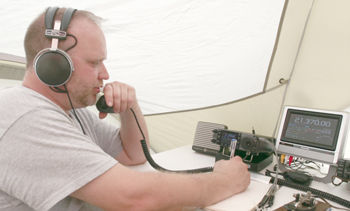Radio Field Day
Published 11:49 pm Saturday, June 23, 2007

- Scott Haner, a member of the Valdosta Amateur Radio Club, communicates with other radio operators around the country during the emergency communications exercise held Saturday at McKey Park.
VALDOSTA — The Valdosta Amateur Radio Club chose a more public location for their annual Field Day event and erected a 30-foot tower in the middle of McKey Park Saturday.
Beginning their 24-hour Field Day at about 2 p.m., the club had already hosted about 20 visitors within the first hour and was expecting a few more throughout the evening. The event began more than 75 years ago as a way to test and hone the emergency capabilities of amateur radio operators for their response during major catastrophes, according to VARC member Scott Haner.
After Hurricane Katrina struck the Gulf Coast, amateur radio was the only form of communication for nearly eight hours when commercial towers were wiped out during the storm. When such circumstances occur, the nation recognizes the truthfulness of the Amateur Radio Relay League’s motto, “When all else fails … amateur radio works.”
Area-wide networks can also be enhanced with surrounding cities, including Albany, Douglas, Moultrie, Thomasville and others to allow for better communication during emergencies.
Field Day events focus on communication throughout the country and Canada, although amateur radio operators can communicate worldwide.
“The love of radio transcends the language barrier,” one club member explained.
Each club participating in the Field Day event around the U.S. competes to earn the most points in their class, which are accumulated based on contacts with other operators, number of visitors and the types and number of stations that are set up among other things. The tower set up for the event, which was equipped with a rotating antenna, will allow the participants to work eight radio frequency bands and has a range of about 2,000 miles.
This year the club operated three stations, one of which was set up for the public to use with the assistance of an operator.
Last year the club placed fourth in the state and this year the goal was to be No. 1.
The event has even reached beyond the limits of the Earth, reaching into space, as ARRL Field Day Coordinator Dan Henderson said he received reports from NASA discussing the International Space Station’s participation during this year’s Field Day.
“As in past years, there is the usual ‘soft’ plan for at least one of the stations on the ISS being activated for a time during Field Day. As always, this is dependent on the astronauts’ work schedule, and always subject to last-minute change,” Henderson said.
For each of the past five or six years, at least one of the residents of the space station has made an appearance during Field Day, according to the ARRL.
Haner said the equipment and technology used in amateur radio has vastly improved over the years. Amateur radio operators can now communicate through the traditional Morse code and voice communication methods in addition to slow-scan and fast-scan television, satellites, and equipment that allows signals to be bounced off the moon or the Earth’s atmosphere in order to travel around the globe.
“It takes skill to operate and that is why we are here, so that we can hone those skills in case of a catastrophe,” Haner said.
VARC was founded in 1927 and chartered by the ARRL in 1947. The club is active in several capacities, including traveling to area amateur radio festivals, offering amateur radio classes and licensing.
The club is also focused on introducing children to the technology to ensure that the necessary skills are carried on.
“In order for America to stay on top we need to be sure that we teach our children,” Haner said.
Anyone interested in becoming an amateur radio operator can visit the VARC website at www.VARC.net to find additional information and contacts. The club holds classes and provides periodic testing for anyone wishing to get their amateur radio operating license. Information on the ARRL can be found at www.ARRL.org.




